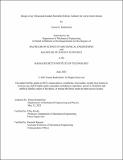Design of an Ultrasound-Guided Steerable Robotic Catheter for Aortic Interventions
Author(s)
Rutherford, Emma (Emma Kristen)
DownloadThesis PDF (14.91Mb)
Advisor
Roche, Ellen
Terms of use
Metadata
Show full item recordAbstract
Endovascular surgery offers minimally invasive solutions to a variety of pathologies affecting blood vessels, such as aneurysms, dissections, and stenoses. During a standard endovascular procedure, the surgeon makes a small puncture in the femoral artery to insert a steerable catheter, and real time x-ray imaging provides guidance as the surgeon maneuvers it to a target site. A variety of interventional devices, such as stents, grafts, and coils can then be delivered through a catheter to reach the treatment area.
While these techniques have many advantages over open surgery, there are still clinical challenges. X-ray vision does not provide a 3-dimensional understanding of the vessels or orientation of the catheter tip, and it is often difficult to distinguish various structures due to poor contrast. It also exposes patients and surgeons to extended periods of radiation. Poor visuals and tedious manipulation often make steering catheters a process of trial and error. Manually steered robotic endovascular systems exist, which assist the surgeon in precise control of the device and reduce the likelihood of human error, but the learning curve associated with them can be steep.
Incorporating autonomous steering has the potential to reduce risks caused by surgeon errors, shorten procedure time, and make robotic endovascular surgery accessible for surgeons. As an alternative to x-ray imaging, it is possible to use ultrasound technology as a procedural guidance technique. Here we investigate the use of the Philips Verisight Pro intracardiac echo system to guide the surgeon and map the intravascular environment. This paper covers the design of an initial prototype of a steerable catheter system which integrates a separate advanced 3D echocardiography catheter. With the development of a robust robotic platform, next steps will be to continue developing and testing a simultaneous localization and mapping (SLAM) algorithm for semi-autonomous decision making, with the goal of developing an endovascular surgical system that can maneuver quicker and more precisely than a manually-manipulated catheter.
Date issued
2023-06Department
Massachusetts Institute of Technology. Department of Mechanical EngineeringPublisher
Massachusetts Institute of Technology